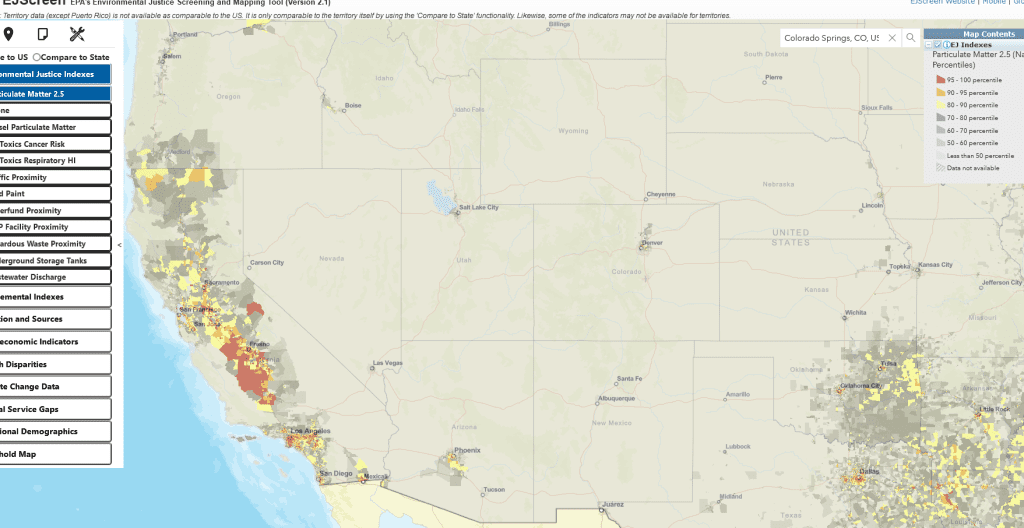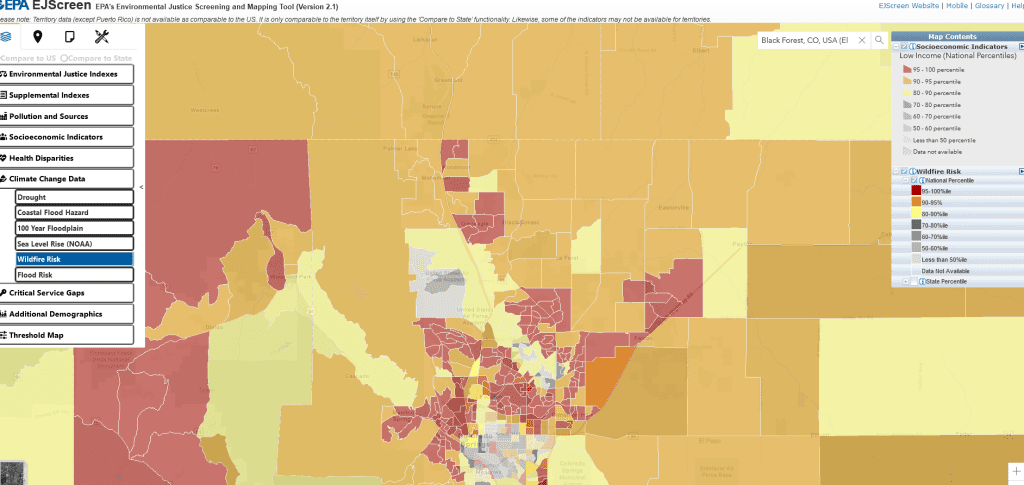Rumor has it that the Forest Service is coming out with new maps for the 10 Year Wildfire Strategy (maybe I’m missing something, but like I said it’s a rumor). Part of it is to prioritize environmental justice, or so I heard. So naturally, inquiring minds would want to know how this fits with the EPA EJ Screen program, which was updated in October. Will the FS use the same maps (base data) and criteria?
How does the EPA use this tool?
EPA uses EJScreen as a preliminary step when considering environmental justice in certain situations. The agency uses it to screen for areas that may be candidates for additional consideration, analysis or outreach as EPA develops programs, policies and activities that may affect communities. In the past, the agency employed EJ screening tools in a wide variety of circumstances.
A few examples of what EJScreen supports across the agency include:
- Informing outreach and engagement practices
- Implementing aspects of the following programs:
- permitting
- enforcement
- compliance
- voluntary
- Developing retrospective reports of EPA work
- Enhancing geographically based initiatives
EJScreen is not used by EPA staff for any of the following:
- As a means to identify or label an area as an “EJ community”
- To quantify specific risk values for a selected area
- To measure cumulative impacts of multiple environmental factors
- As the sole basis for agency decision-making or making a determination regarding the existence or absence of EJ concerns
EPA hopes to refine our uses of EJScreen as we build upon lessons learned and as we receive feedback from our stakeholders and governmental partner
The map also has “climate” risks, including wildfire risk. If you happen to be a yellow box in the middle of orange boxes (see above) you might wonder how this fits with other wildfire risk maps. Someone out there probably knows. But it’s always fun to ground truth these maps so take a look at your neighborhood.
Oregon Public Broadcasting has a lengthy story about the state wildfire risk mapping effort that met with public blowback. Apparently the second time around, Oregon will issue a draft and allow people to comment on it.
I wonder whether EPA did that. It seems to me that for something as important as EJ, the public should have been involved in definitions, reviewing data and all that. And perhaps we were, but I was not on the right mailing list.
 I wonder how they considered wildfire smoke in this PM 2.5 listing?
I wonder how they considered wildfire smoke in this PM 2.5 listing?

In simpler times, when wildland fire was no longer the driver for all things of Federal land management, the primitive people attacked fires at first discovery. It used to be that the first Oregon Dept of Forestry employee was the IC until relieved by a named IC. Summer employees driving a brush truck with a 300 gallon tank could be the IC with one SRB. They were fighting fire and keeping communications informed, doing their best until help arrived.
Now there is so much planning and marshaling of resources that project fires are the unintended consequence of the process of bureaucratic, measurable response in a CYA exercise for public consumption. In a word: a lot more first responders with agency backup to order resources to “kill snakes” with a vengeance is modern warfare, and maybe should be wildland fire process.
My particular issue is that a century ago they fought Federal land fires by hand using a trail complex that was maintained and improved every year. Now the USFS primarily uses volunteers to clear a paucity of trail miles. Why does a professional organization depend on amateurs volunteering time to do necessary maintenance. Is there a volunteer painting crew to maintain Capitol buildings? Wash and wax the Presidential limos and SS armored vehicles? Better there is a seasonal worker system tied to university education credits and tuition vouchers. Pay to get the work done. Certainly there is administrative staff enough. If not, how does an army work with more officers than there are front line soldiers?
When I was a longterm Temporary Employee, I created a nickname for us, to show permanents that we are “Disposables”. They didn’t really like this very accurate term, but it was one that some of us did embrace. Sometimes a dose of reality helps, but it was too easy for the Agency to just push the blame farther up the ladder, as if there was nothing they could do about the problem.
I think there is still a bunch of acute bitterness towards the Agency for the poor treatment of Temps. The Feds made their beds, and now they have to sleep in them. This problem is far from over with, too. They still have to sort out the unsuitable folks they just hired. They also have to put up with the mistakes made by those new employees, who don’t understand all the rules, laws and policies that must be followed.
AND, there will be more retirements of key people, which will be ‘back-filled’ by people learning a new job, to gain their precious “High-3”, before their own retirements.